Click on images to enlarge
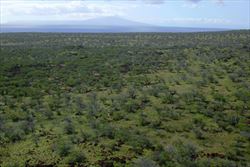
large infestation (Photo: Forest and Kim Starr, USGS)
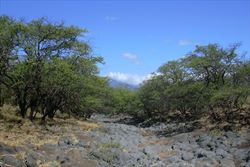
infestation (Photo: Forest and Kim Starr, USGS)
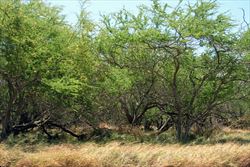
habit (Photo: Forest and Kim Starr, USGS)

habit (Photo: Sheldon Navie)
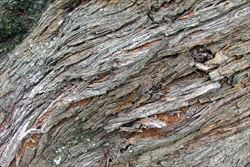
mature trunk (Photo: Sheldon Navie)
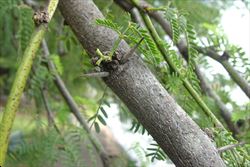
older branch with spines (Photo: Sheldon Navie)
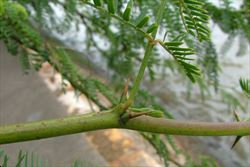
younger branch with spines (Photo: Sheldon Navie)
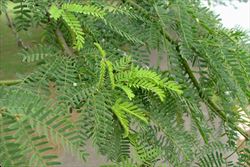
leaves (Photo: Sheldon Navie)
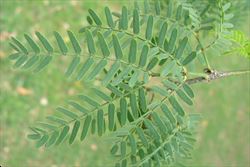
twice-compound leaf (Photo: Sheldon Navie)
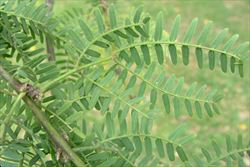
leaf undersides (Photo: Sheldon Navie)
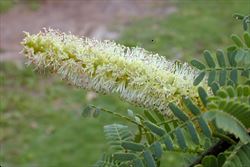
elongated flower cluster (Photo: Forest and Kim Starr, USGS)
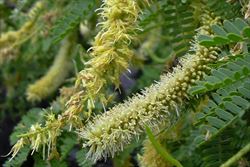
close-up of flowers (Photo: Forest and Kim Starr, USGS)

immature and mature fruit (Photo: Forest and Kim Starr, USGS)
Scientific Name
Prosopis pallida (Humb. & Bonpl. ex Willd.) Kunth
Synonyms
Acacia pallida Willd.Mimosa pallida Poir.Prosopis limensis Benth.
Family
Fabaceae: sub-family Mimosoideae (New South Wales)Leguminosae (South Australia)Mimosaceae (Queensland, the ACT, Victoria, Tasmania, Western Australia and the Northern Territory)
Common Names
algaroba, algarrobo, Cloncurry prickle bush, kiawe, mesquite
Origin
Native to the north-western parts of South America (i.e. Peru, Columbia and Ecuador).
Naturalised Distribution
This species is widespread throughout northern Australia, particularly in inland regions. It is most common in the north-western areas of Queensland and in the central regions of the Northern Territory. Scattered populations occur in southern and central Queensland, inland northern New South Wales, coastal northern Western Australia and other parts of the Northern Territory.
Also naturalised in Puerto Rico, Brazil, Hawaii, the Marquesas, India, southern Africa and New Guinea.
Habitat
Algaroba (Prosopis pallida) is mostly found in wetter habitats within semi-arid and arid environments (i.e. along creeks, in gullies, in intermittent stream-beds, etc.). It also grows along roadsides, in pastures, in open woodlands and near habitation.
Habit
A spiny tree usually growing less than 10 m tall, but occasionally reaching up to 15 m in height.
Distinguishing Features
- usually a single-stemmed tree with younger branches that often have a zig-zagging appearance.
- pairs of spines are usually present just above each leaf fork.
- its leaves are twice-compound and usually have two to four pairs of branchlets, each bearing numerous elongated leaflets.
- its fluffy yellowish flowers are arranged in elongated clusters (5-14 cm long).
- its large, elongated, pods (8-20 cm long and 7-15 mm wide) contain several hard seeds.
Stems and Leaves
The bark of older branches is usually rough, fissured, and grey, brown or blackish in colour. Younger branches have smooth bark, are green or reddish in colour, and often have a zig-zagging pattern to their growth. They are sometimes sparsely hairy (i.e. puberulent), but generally become hairless (i.e. glabrous) with age. The stems are almost always armed with a pair of spines (3-17 mm long) just above each leaf fork (i.e. axil).
The leaves are alternately arranged, twice-compound (i.e. bipinnate), and fern-like in appearance. They are borne on finely hairy stalks (i.e. puberulous petioles) 8-20 mm long and usually have two to four pairs of branchlets (i.e. pinnae). Each branchlet (i.e. pinna) is 2-5 cm long and bears 7-15 pairs of oblong to slightly elongated leaflets (i.e. pinnules). These leaflets (2-10 mm long and 1.4-4 mm wide) are generally about 2-4 times longer than they are broad. They are usually somewhat hairy (i.e. pubescent) on both sides and have weakly pointed or rounded tips (i.e. acute or obtuse apices).
Flowers and Fruit
The flowers are arranged in elongated, cylindrical, clusters (i.e. racemes). These flower clusters (8-12 cm long) are borne on stalks (i.e. peduncles) 4-30 mm long and two to five of them can arise from a single leaf fork (i.e. axil). The small flowers are greenish, whitish, cream or more commonly yellowish in colour. They consist of five inconspicuous sepals (0.5-1 mm long) that are joined into a short tube (i.e. calyx tube), five small petals (1.5-3 mm long) that are joined together at the base, and 10 prominent stamens (5-6 mm long). Flowering occurs mostly during summer.
The fruit is a large elongated pod (6-25 cm long and 7-15 mm wide) that often has slight constrictions between each of the seeds. These pods are hairless (i.e. glabrous) and turn from green to yellowish-brown as they mature. They contain 5-20 hard seeds that are embedded in a sugary pulp. The seeds (4-7 mm long and 2.5-5 mm wide) are oval (i.e. ellipsoid) in shape, glossy in appearance, and brown or reddish-brown in colour.
Reproduction and Dispersal
Algaroba (Prosopis pallida) reproduces mainly by seed, however existing stands can become more dense through suckering and layering.
Seeds are most commonly dispersed after being eaten by animals. They are also spread by floodwaters, in mud attached to vehicles and machinery, and by other human activities.
Environmental Impact
Algaroba (Prosopis pallida) is regarded as a significant environmental weed in Queensland, the Northern Territory and Western Australia, and as apotential environmental weed or "sleeper weed" in other parts of Australia. This species is actively managed by community groups in Queensland and the mesquites (Prosopis spp.), as a group, are also one of the 20 Weeds of National Significance (WoNS) in Australia.
Legislation
This species is declared under legislation in the following states and territories:
- ACT: C4 - prohibited pest plant (a pest plant whose propagation and supply is prohibited).
- New South Wales: Class 2 - a regionally prohibited weed. The presence of the weed must be notified to the local control authority and it must be eradicated from the land and the land must be kept free of the plant (in a large number of local authority areas). See the New South Wales Department of Primary Industries Noxious Weeds List at http://www.dpi.nsw.gov.au for more detailed information on which local areas are covered in these declarations.
- Northern Territory: A - to be eradicated (throughout all of the Territory) and, C - not to be introduced into the Territory.
- Queensland: Class 2 - landowners must take all reasonable steps to keep land free of this species (throughout the entire state). It is also illegal to sell a declared plant or its seed in this state.
- South Australia: 1N# - this species is declared in Class 1c(ii), a classification for prohibited terrestrial plants. The presence of this species must be notified and it must be destroyed (throughout the entire state) - not including seasoned dry timber.
- Tasmania: D - the importation or sale of this species is prohibited and measures to reduce its population in an area, eradicate it from an area, or restrict it to a particular area may be required.
- Victoria: S - prohibited and are to be eradicated from the state if possible.
- Western Australia: P1 - trade, sale or movement into the state prevented (throughout the entire state), P2 - to be eradicated (throughout most of the state), and P4 - infestations to be contained (in a small part of the state only). See the Western Australian Department of Agriculture and Food Declared Plant List at http://www.agric.wa.gov.au/ for more detailed information about which areas are covered by these declarations.
Note: All of these declarations, except those for Queensland, apply to all mesquite species (Prosopis spp.).
Management
For information on the management of this species see the following resources:
- the National Weeds Strategy Strategic Plan for mesquite (Prosopis species), which is available online at http://www.weeds.org.au/docs/msqstrat.pdf.
- the Best Practice Manual for mesquite, which is available online at http://www.weeds.org.au/WoNS/mesquite/.
- the Biosecurity Queensland Fact Sheet on this species, which is available online at http://www.dpi.qld.gov.au.
- the Northern Territory Department of Natural Resources, Environment and The Arts Agnote on this species, which is available online at http://www.nt.gov.au/weeds.
- the Victorian Department of Primary Industries Landcare Note on mesquite, which is available online at http://www.dpi.vic.gov.au.
- the Western Australian Department of Agriculture and Food Farmnote on mesquite, which is available online at http://www.agric.wa.gov.au.
Similar Species
It is very difficult to distinguish between individual mesquite species (Prosopis spp.), as hybrids and intermediates between them often occur in the field. However, the following general differences are apparent between the four main species present in Australia:
- algaroba (Prosopis pallida) usually has a pair of small spines (3-17 mm long) near where the leaves join to the stem. Its twice-compound (i.e. bipinnate) leaves have two to four pairs of branchlets (i.e. pinnae) and their stalks are finely hairy (i.e. puberulent). The slightly elongated leaflets are about 2-4 times as long as they are wide (2-10 mm long and 1.4-4 mm wide). Its pods are hairless (i.e. glabrous) and turn yellowish-brown when mature.
- velvet mesquite (Prosopis velutina) usually has a pair of relatively large spines (8-40 mm long) near where the leaves join to the stem. Its twice-compound (i.e. bipinnate) leaves have one or two pairs of branchlets (i.e. pinnae) and their stalks are either hairless or hairy (i.e. glabrous or pubescent). The slightly elongated leaflets are 3-4.5 times as long as they are wide (6-12 mm long and 1.8-3.7 mm wide). Its pods are densely covered in fine hairs (i.e. velutinous) and turn reddish-brown or yellowish when mature.
- honey mesquite (Prosopis glandulosa var. glandulosa) usually has a single large spine (20-60 mm long) near where the leaves join to the stem. Its twice-compound (i.e. bipinnate) leaves have one or two pairs of branchlets (i.e. pinnae) and their stalks are hairless (i.e. glabrous). The very elongated leaflets are 5-15 times as long as they are wide (15-65 mm long and 2-5 mm wide). Its pods are hairless (i.e. glabrous) and turn reddish-purple or straw-coloured when mature.
- mesquite (Prosopis juliflora) has one or two small spines (5-15 mm long) near where the leaves join to the stem. Its twice-compound (i.e. bipinnate) leaves have one to three pairs of branchlets (i.e. pinnae) and their stalks are hairless (i.e. glabrous) or somewhat hairy (i.e. pubescent). The elongated leaflets are 3-6 times as long as they are wide (10-16 mm long and 1.5-3 mm wide). Its pods are hairless (i.e. glabrous) and turn brown or straw-coloured when mature.
The mesquites (Prosopis spp.) can also be confused with several other woody weeds, including prickly acacia (Acacia nilotica), mimosa bush (Acacia farnesiana) and parkinsonia (Parkinsonia aculeata). All of these species have spines, twice-compound (i.e. bipinnate) leaves, yellow flowers and elongated seed pods. However, algaroba (Prosopis pallida) can be distinguished from these species by its elongated cylindrical flower clusters. Prickly acacia (Acacia nilotica ) can also be distinguished by its strongly constricted seed pods, mimosa bush (Acacia farnesiana) by its shorter (less than 6 cm long) pods, and parkinsonia (Parkinsonia aculeata) by its greenish-coloured stems and drooping strap-like leaves.
See the the Biosecurity Queensland Fact Sheet on Identification of Prickle Bushes for more help with distinguishing between some of these species.

